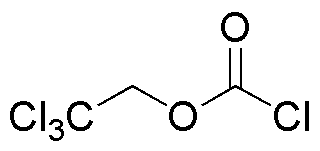2,2,2-Trichloroethyl chloroformate is widely utilized in research focused on:
- Synthesis of Pharmaceuticals: This compound serves as an important intermediate in the synthesis of various pharmaceutical agents, enabling the creation of complex molecules efficiently.
- Production of Agrochemicals: It is utilized in the formulation of pesticides and herbicides, helping to enhance crop protection and yield in the agricultural sector.
- Polymer Chemistry: This chemical acts as a reagent in the production of specialty polymers, contributing to materials with unique properties for industrial applications.
- Laboratory Reagent: In research laboratories, it is commonly used for chlorination reactions, facilitating the introduction of chlorine into organic compounds.
- Environmental Applications: It is explored for use in the development of environmentally friendly solvents and reagents, addressing the need for sustainable chemical processes.
General Information
Properties
Safety and Regulations
Applications
2,2,2-Trichloroethyl chloroformate is widely utilized in research focused on:
- Synthesis of Pharmaceuticals: This compound serves as an important intermediate in the synthesis of various pharmaceutical agents, enabling the creation of complex molecules efficiently.
- Production of Agrochemicals: It is utilized in the formulation of pesticides and herbicides, helping to enhance crop protection and yield in the agricultural sector.
- Polymer Chemistry: This chemical acts as a reagent in the production of specialty polymers, contributing to materials with unique properties for industrial applications.
- Laboratory Reagent: In research laboratories, it is commonly used for chlorination reactions, facilitating the introduction of chlorine into organic compounds.
- Environmental Applications: It is explored for use in the development of environmentally friendly solvents and reagents, addressing the need for sustainable chemical processes.
Documents
Safety Data Sheets (SDS)
The SDS provides comprehensive safety information on handling, storage, and disposal of the product.
Product Specification (PS)
The PS provides a comprehensive breakdown of the product’s properties, including chemical composition, physical state, purity, and storage requirements. It also details acceptable quality ranges and the product's intended applications.
Certificates of Analysis (COA)
Search for Certificates of Analysis (COA) by entering the products Lot Number. Lot and Batch Numbers can be found on a product’s label following the words ‘Lot’ or ‘Batch’.
*Catalog Number
*Lot Number
Certificates Of Origin (COO)
This COO confirms the country where the product was manufactured, and also details the materials and components used in it and whether it is derived from natural, synthetic, or other specific sources. This certificate may be required for customs, trade, and regulatory compliance.
*Catalog Number
*Lot Number
Safety Data Sheets (SDS)
The SDS provides comprehensive safety information on handling, storage, and disposal of the product.
DownloadProduct Specification (PS)
The PS provides a comprehensive breakdown of the product’s properties, including chemical composition, physical state, purity, and storage requirements. It also details acceptable quality ranges and the product's intended applications.
DownloadCertificates of Analysis (COA)
Search for Certificates of Analysis (COA) by entering the products Lot Number. Lot and Batch Numbers can be found on a product’s label following the words ‘Lot’ or ‘Batch’.
*Catalog Number
*Lot Number
Certificates Of Origin (COO)
This COO confirms the country where the product was manufactured, and also details the materials and components used in it and whether it is derived from natural, synthetic, or other specific sources. This certificate may be required for customs, trade, and regulatory compliance.


